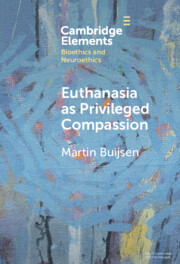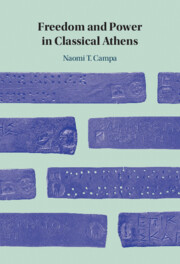521 results
Chapter 6 - The Aim of Medicine I
-
- Book:
- Science, Medicine, and the Aims of Inquiry
- Published online:
- 16 May 2024
- Print publication:
- 23 May 2024, pp 132-162
-
- Chapter
- Export citation
Chapter 7 - The Aim of Medicine II
-
- Book:
- Science, Medicine, and the Aims of Inquiry
- Published online:
- 16 May 2024
- Print publication:
- 23 May 2024, pp 163-182
-
- Chapter
- Export citation
Intellectual Virtue Signaling and (Non)Expert Credibility
-
- Journal:
- Journal of the American Philosophical Association , First View
- Published online by Cambridge University Press:
- 22 May 2024, pp. 1-17
-
- Article
- Export citation

Euthanasia as Privileged Compassion
-
- Published online:
- 17 May 2024
- Print publication:
- 30 June 2024
-
- Element
-
- You have access
- Open access
- HTML
- Export citation
Self-Determination and the Value of Nationality
-
- Journal:
- Canadian Journal of Philosophy , FirstView
- Published online by Cambridge University Press:
- 17 May 2024, pp. 1-21
-
- Article
-
- You have access
- Open access
- HTML
- Export citation
Pluralist Theories of Wrongful Discrimination
-
- Journal:
- Dialogue: Canadian Philosophical Review / Revue canadienne de philosophie / Volume 63 / Issue 1 / April 2024
- Published online by Cambridge University Press:
- 23 April 2024, pp. 9-20
-
- Article
-
- You have access
- Open access
- HTML
- Export citation
Individual Maxim Tokens, not Abstract Maxim Types
-
- Journal:
- Kantian Review , First View
- Published online by Cambridge University Press:
- 22 April 2024, pp. 1-17
-
- Article
- Export citation
Chapter 3 - What Makes Solitude Great?
-
- Book:
- Solitude
- Published online:
- 24 March 2024
- Print publication:
- 18 April 2024, pp 52-64
-
- Chapter
- Export citation
When Two Become One: Singular Duos and the Neuroethical Frontiers of Brain-to-Brain Interfaces
-
- Journal:
- Cambridge Quarterly of Healthcare Ethics , First View
- Published online by Cambridge University Press:
- 12 April 2024, pp. 1-13
-
- Article
-
- You have access
- Open access
- HTML
- Export citation
Chapter 2 - Democratic Eleutheria as Positive Freedom
-
- Book:
- Freedom and Power in Classical Athens
- Published online:
- 04 April 2024
- Print publication:
- 11 April 2024, pp 18-55
-
- Chapter
- Export citation
Chapter 6 - Conclusion
-
- Book:
- Freedom and Power in Classical Athens
- Published online:
- 04 April 2024
- Print publication:
- 11 April 2024, pp 166-174
-
- Chapter
- Export citation

Freedom and Power in Classical Athens
-
- Published online:
- 04 April 2024
- Print publication:
- 11 April 2024
Refusals and Requests: In Defense of Consistency
-
- Journal:
- Cambridge Quarterly of Healthcare Ethics , First View
- Published online by Cambridge University Press:
- 19 March 2024, pp. 1-11
-
- Article
- Export citation
23 - The Political Necessity and Perilous Ambiguity of “Academic Freedom”
- from Part II - Ethics and Education in Practice
-
-
- Book:
- The Cambridge Handbook of Ethics and Education
- Published online:
- 07 March 2024
- Print publication:
- 14 March 2024, pp 485-508
-
- Chapter
- Export citation
20 - School Discipline and the Ethics of Punishment
- from Part II - Ethics and Education in Practice
-
-
- Book:
- The Cambridge Handbook of Ethics and Education
- Published online:
- 07 March 2024
- Print publication:
- 14 March 2024, pp 422-442
-
- Chapter
- Export citation
3 - The “Autonomy” of the EU Legal Order as a Self-Standing Theory?
- from Part I - Common Theories on the Relationship of Legal Orders and Their Flaws Concerning the EU Legal Order
-
- Book:
- Rethinking the Relationship between International, EU and National Law
- Published online:
- 29 February 2024
- Print publication:
- 14 March 2024, pp 95-110
-
- Chapter
- Export citation
Central bank power without central bank autonomy?
-
- Journal:
- Finance and Society / Volume 10 / Issue 1 / April 2024
- Published online by Cambridge University Press:
- 05 March 2024, pp. 65-68
-
- Article
-
- You have access
- Open access
- HTML
- Export citation
9 - Adolescent Autonomy
-
- Book:
- Fortin's Children's Rights and the Developing Law
- Published online:
- 08 February 2024
- Print publication:
- 29 February 2024, pp 339-371
-
- Chapter
- Export citation
Striving for autonomy and feminism: What possibilities for Saudi Women?
-
- Article
-
- You have access
- Open access
- HTML
- Export citation
What Is a Society? Building an Interdisciplinary Perspective and Why That's Important
-
- Journal:
- Behavioral and Brain Sciences / Accepted manuscript
- Published online by Cambridge University Press:
- 23 February 2024, pp. 1-72
-
- Article
- Export citation



